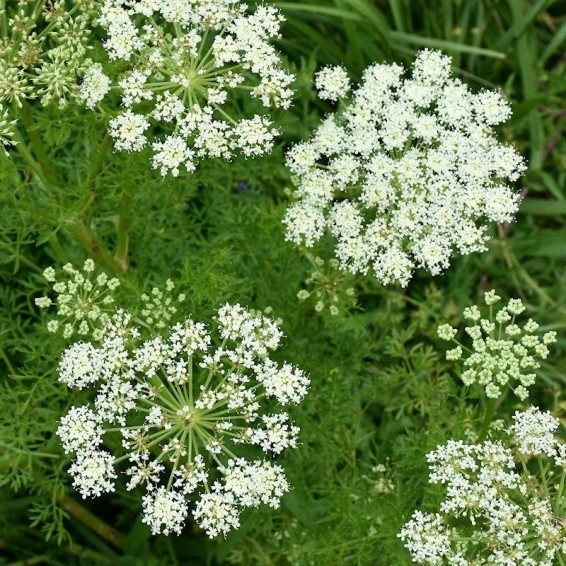Organic Caraway Seeds
Carum carvi
- HOW TO GROW
- FAST FACTS
HOW TO GROW
Sowing: Caraway grows best in sandy or well drained soil and full sun. It does not transplant well, so direct sowing after the last spring frost is recommended. Plant the seeds 1/4" deep in rows 18" apart, later thinning the seedlings to 6-8" apart. Germination of caraway is notoriously slow. Caraway can also be planted in the fall.
Growing: Keep the soil evenly moist until the plant is established, taking care not to get the foliage wet to prevent disease. After the plant has grown to some height, it can survive quite well in dry soil. Control weeds, especially when the plants are small.
Harvesting: Fresh caraway leaves, which have a flavor similar to dill and are often used in salads, can be harvested at any time after the plant reaches a moderate height. The seeds will not be produced until late summer of the plant's second year. Remove the seed heads as soon as the seeds begin to mature, since they shatter easily. Rub the heads lightly to separate the seed from the heads, and store them in an airtight container.
Seed Saving: This variety of caraway, being biennial, will not produce seed until the late summer of its second year; in cold regions, a layer of mulch may be necessary for protection. The seeds will begin to mature about a month after the plant begins flowering. Remove the seed heads as soon as the seeds begin to mature, since they shatter easily. Rub the heads lightly to separate the seed from the heads. Store the seeds in a cool, dry place and use as soon as possible.
FAST FACTS
Common Names: Meridian Fennel, Persian Cumin
Latin Name: Carum carvi
Species Origin: Western Asia, Europe, North Africa
Type: Open Pollinated, Heirloom, Warm Season
Life Cycle: Biennial
USDA Zones: 3, 4, 5, 6, 7, 8, 9, 10, 11, 12
Seeds per Ounce: 10,000
Planting Method: Direct Sow
Planting Depth: 0.1
Planting Spacing: 12
Row Spacing: 16
Days to Maturity: 365
Sunlight: Full Sun, Part Sun
Height: 24 Inches
Color: White
Bloom Season: Blooms Early Summer, Blooms Late Summer
Uses: Aromatic
DESCRIPTION
HOW TO GROW
Sowing: Caraway grows best in sandy or well drained soil and full sun. It does not transplant well, so direct sowing after the last spring frost is recommended. Plant the seeds 1/4" deep in rows 18" apart, later thinning the seedlings to 6-8" apart. Germination of caraway is notoriously slow. Caraway can also be planted in the fall.
Growing: Keep the soil evenly moist until the plant is established, taking care not to get the foliage wet to prevent disease. After the plant has grown to some height, it can survive quite well in dry soil. Control weeds, especially when the plants are small.
Harvesting: Fresh caraway leaves, which have a flavor similar to dill and are often used in salads, can be harvested at any time after the plant reaches a moderate height. The seeds will not be produced until late summer of the plant's second year. Remove the seed heads as soon as the seeds begin to mature, since they shatter easily. Rub the heads lightly to separate the seed from the heads, and store them in an airtight container.
Seed Saving: This variety of caraway, being biennial, will not produce seed until the late summer of its second year; in cold regions, a layer of mulch may be necessary for protection. The seeds will begin to mature about a month after the plant begins flowering. Remove the seed heads as soon as the seeds begin to mature, since they shatter easily. Rub the heads lightly to separate the seed from the heads. Store the seeds in a cool, dry place and use as soon as possible.
FAST FACTS
Common Names: Meridian Fennel, Persian Cumin
Latin Name: Carum carvi
Species Origin: Western Asia, Europe, North Africa
Type: Open Pollinated, Heirloom, Warm Season
Life Cycle: Biennial
USDA Zones: 3, 4, 5, 6, 7, 8, 9, 10, 11, 12
Seeds per Ounce: 10,000
Planting Method: Direct Sow
Planting Depth: 0.1
Planting Spacing: 12
Row Spacing: 16
Days to Maturity: 365
Sunlight: Full Sun, Part Sun
Height: 24 Inches
Color: White
Bloom Season: Blooms Early Summer, Blooms Late Summer
Uses: Aromatic





